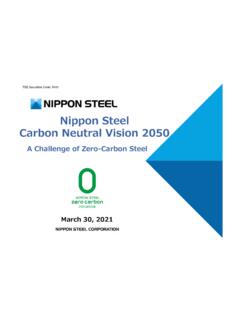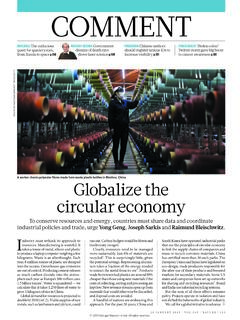Transcription of Life cycle assessment 1/38 Carbon footprint of Polestar 2
1 life cycle assessment 1/38.. Carbon footprint of Polestar 2. 2. life cycle assessment 2/38.. Disclaimer Disclaimer This report is informational only and (1) is based solely on an analysis of Polestar 2 (model year 2020) and Volvo XC40 petrol internal combustion engine (model year 2020) and does not include information regarding any other Polestar or Volvo Cars vehicle and (2) does not create any commitment regarding current or future products or Carbon footprint impacts. life cycle assessment 3/38.. Contents Contents Executive summary 4. Author 6. Terms and definitions 7. 1 General description of life cycle assessment (LCA) 9.
2 Principles of LCA 9. LCA standards 9. 2 Methodology 11. The products 11. Way of working overview 11. Methodology to define vehicle material composition 11. Goal and scope definition 12. System boundaries 13. Function, functional unit and reference flows 13. Allocations 14. System expansion 14. Assumptions and limitations 14. 3 life cycle Inventory analysis (LCI) 15. Material production and refining 15. Aluminium production and refining 15. Steel production and refining 16. Electronics production and refining 16. Plastics production and refining 16. Minor material categories, production and refining 16. Electricity use in materials production and refining 16.
3 Battery modules 17. Manufacturing and logistics 17. Logistics 17. Manufacturing 17. Use phase 17. End-of- life of the vehicle 18. Process description 18. 4 Results for Polestar 2 20. Polestar 2 compared to XC40 ICE (petrol) 20. 5 Discussion 23. Qualitative sensitivity analysis 23. Possible future work 24. 6 Conclusions 25. Appendix 1 General methodology when choosing datasets for complete vehicle Carbon footprints 26. Appendix 2 Chosen datasets 28. Appendix 3 Complete list of IDMS Material Library material categories 34. Appendix 4 Summary of data choices and assumptions for component manufacturing 36. Appendix 5 End-of- life assumptions and method 37.
4 Transport 37. Disassembly 37. Pre-treatment 37. Shredding 37. Material recycling 37. Final disposal incineration and landfill 37. Data collection 38. life cycle assessment 4/38.. Executive summary Executive summary The Carbon footprint presented in this report is based on a life cycle assessment (LCA), performed in this study according to ISO LCA standards1. In addition, the Product life cycle Accounting and Reporting Standard 2 published by the Greenhouse Gas Protocol has been used for guidance in methodological choices. Given the great number of variables and possible methodological choices in LCA studies, these standards generally provide few strict requirements to be followed.
5 Instead they mostly provide guidelines for the practitioner. For this reason, care should be taken when comparing our results with results from other vehicle manufacturers' Carbon footprints. In general, assumptions have been made in a conservative way, in order to not underestimate the impact from unknown data. The LCA and the underlying methodology will be used as the metric for assessing the Carbon footprint of Polestar 's cars. The calculation will be performed regularly and serve as a framework for measuring green house gas (GHG) reduction related activities. Major work has been put in to building the methodology.
6 The methodology will be continuously developed and used to compile future Carbon footprints for Polestar vehicles. The methodology will also be expanded to incor- porate additional environmental impact categories. The work was carried out during 2020 as a collaboration between Polestar and Volvo Cars, and as a comparison a Carbon footprint has also been determined for the Volvo Cars XC40 petrol internal combustion engine vehicle (XC40 ICE). Figure 1. Tonne XC40 Polestar 2 Polestar 2 Polestar 2. CO e ICE Global electricity mix European electricity mix Wind power Carbon footprint for Polestar 2 and XC40. 58.
7 ICE, with different electricity mixes in the use phase used for Polestar 2. Results are shown in tonne CO2-equivalents per func- 50. tional unit (200,000 km lifetime range). 60. n n n Materials production Li-ion battery modules Manufacturing 50. 42. 27. n Use phase 40. n End-of- life 30. 20. 10. 0. The Carbon footprint includes emissions from upstream supplier activities, manufacturing and logistics, use phase of the vehicle and the end-of- life phase. The functional unit chosen is The use of a specific Polestar vehicle driving 200,000 km . As the production of the BEV's Li-ion battery has a relatively large Carbon footprint and con- tribution to the total Carbon footprint of a vehicle, a separate Carbon footprint study has been performed in collaboration with our battery module suppliers.
8 The Carbon footprint from the rest of the BEV battery pack is included in the Materials production . The two main differences in the Carbon footprint between the Polestar 2 and the ICE appear in the materials production (including the Li-ion battery modules) and the use phase. The Carbon footprint from materials production (including the Li-ion battery modules) of the ICE is roughly 40% less than for Polestar 2. Looking at the category Materials production the five main contributors for the XC40 ICE are aluminum 34%, steel and iron 34%, electronics 13%, polymers 11% and fluids and undefined 4% (see Figure 10 for more details).
9 For Polestar 2 the main contributors to the Carbon footprint of the material production (including Li-ion battery modules) are aluminum 29%, Li-ion battery modules 29%, steel and iron 17%, electronics 10%. and polymers 7% (see Figure 10 for more details). 1 ISO 14044:2006 Environmental management life cycle assessment . Requirements and guidelines and ISO It should be noted that the Carbon footprint was performed to represent a globally sourced 14040:2006 Environmental management version of the car models. Other methodological choices that have a large impact on the result life cycle assessment Principles and framework are choice of allocation method regarding scrap, and choice of datasets for steel and alumin- ium production.
10 2 files/standards/Product- life - cycle - life cycle assessment 5/38.. Executive summary Total use phase GHG emissions from the Polestar 2 vary greatly depending on the Carbon intensity of the electricity used. It should be noted that a BEV sold on a market with Carbon -in- tensive electricity production can be charged with electricity from renewable energy. This would decrease the Carbon footprint substantially. Furthermore, the results assume a con- stant Carbon intensity throughout the vehicle lifetime. Figure 2 below shows the total of GHG emissions , depending on kilometres driven, from Polestar 2 (with different electricity mixes in the use phase in the diagram), and XC40 ICE (ICE.)






